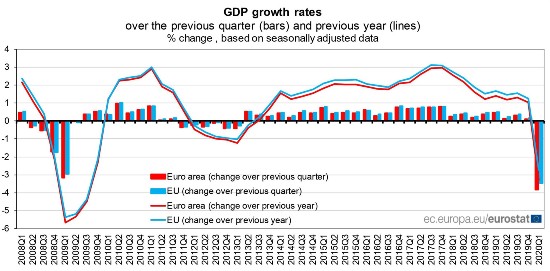Seasonally adjusted GDP decreased by 3.8% in the euro area and by 3.5% in the EU during the first quarter of 2020, compared with the previous quarter, according to a preliminary flash estimate published by Eurostat, the statistical office of the European Union.
These were the sharpest declines observed since time series started in 1995. In March 2020, the final month of the period covered, COVID-19 containment measures began to be widely introduced by Member States. In the fourth quarter of 2019, GDP had grown by 0.1% in the euro area and by 0.2% in the EU.
Compared with the same quarter of the previous year, seasonally adjusted GDP decreased by 3.3% in the euro area and by 2.7% in the EU in the first quarter of 2020, after +1.0% and +1.3% respectively in the previous quarter. These were the sharpest declines since the third quarter of 2009 (-4.5% for euro area and -4.4% for EU).
READ ALSO : Eurozone GDP rises 0.4% in Q1 2019

Euro area unemployment at 7.4%
In March 2020, the month when COVID-19 containment measures began to be widely introduced by Member States, the euro area seasonally-adjusted unemployment rate was 7.4%, up from 7.3% in February 2020. The EU unemployment rate was 6.6% in March 2020, up from 6.5% in February 2020. These figures are published by Eurostat, the statistical office of the European Union.
Eurostat estimates that 14.141 million men and women in the EU, of whom 12.156 million in the euro area, were unemployed in March 2020. Compared with February 2020, the number of persons unemployed increased by 241,000 in the EU and by 197,000 in the euro area.
In March 2020, 2.763 million young persons (under 25) were unemployed in the EU, of whom 2.275 million were in the euro area. In March 2020, the youth unemployment rate was 15.2% in the EU and 15.8% in the euro area, up from 14.8% and 15.4% respectively in the previous month. Compared with February 2020, youth unemployment increased by 59,000 in the EU and by 52,000 in the euro area.
In March 2020, the unemployment rate for women was 7.0% in the EU, up from 6.7% in February 2020. The unemployment rate for men was 6.3% in March 2020, compared with 6.2% in February 2020. While in the euro area the unemployment rate remained stable for men in March 2020 compared with February 2020 (at 7.0%), it increased from 7.6% to 7.8% between February and March 2020 for women.
Euro area (EA19): Belgium, Germany, Estonia, Ireland, Greece, Spain, France, Italy, Cyprus, Latvia, Lithuania, Luxembourg, Malta, the Netherlands, Austria, Portugal, Slovenia, Slovakia and Finland.
European Union (EU27): Belgium, Bulgaria, Czechia, Denmark, Germany, Estonia, Ireland, Greece, Spain, France, Croatia, Italy, Cyprus, Latvia, Lithuania, Luxembourg, Hungary, Malta, the Netherlands, Austria, Poland, Portugal, Romania, Slovenia,
Slovakia, Finland and Sweden





















